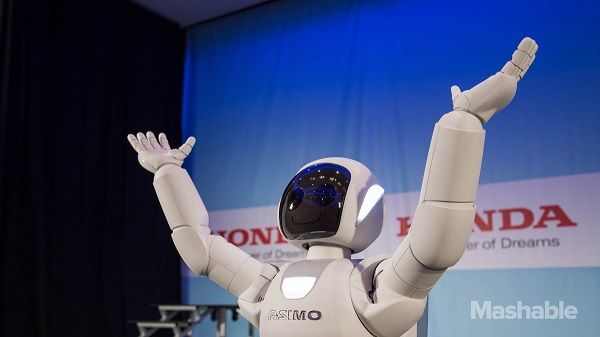
25 robot teams competed in the DARPA robot challenge over the past two days. The best robots from around to world have competing in simulated disaster-response situations to win the $2 million...

The latest version of Google’s humanoid robot no longer draws its power through a cord. Now that it is able to run on battery power alone, ATLAS will be able to compete in the DARPA Robotics Challenge (DRC) finals.
Having no strings attached was actually one of the requirements to qualify in the finals of the challenge, so there really was no alternative to this. First developed by Boston Dynamics in 2013 and now a property of Google, following the acquisition, the ATLAS humanoid robot has gone through many upgrades in the recent past, all to make it compliant with the DRC prerequisites.
“The introduction of a battery and variable-pressure pump into Atlas poses a strategic challenge for teams,” stated Gill Pratt, program manager for the DRC. “The operator will be able to run the robot on a mid-pressure setting for most operations to save power, and then apply bursts of maximum pressure when additional force is needed. The teams are going to have to game out the right balance of force and battery life to complete the course.”
Standing 1.88m tall and weighing 165 kg, ATLAS might look like a lean, mean, killing machine, especially since it also knows karate moves now, but you’d have to wait some more for the robot apocalypse (or is it termination in this context?) to happen. The onboard 3.7-kilowatt-hour lithium-ion battery pack only supplies the robot with enough power for it to walk or use various tools up to one hour.
“Risk mitigation is part of the game,” mentioned Pratt. “It’s up to the teams to decide what chances they’re willing to take during training and risk falls and damage, but come the DRC Finals, the cords are cut.”
We’ll have to wait until June 5 to see how ATLAS and the other robots (six of which are based on the same platform) will perform. That’s when the DRC finals are taking place, but I’m almost certain this is not the last time we hear about this humanoid robot till then. The roboticists that are working on it will surely fined new things to add and new technologies to implement, to make certain the victory is theirs. I can’t imagine Google not winning this challenge, but that doesn’t mean there’s no room for surprises.
Be social! Follow Walyou on Facebook and Twitter, and read more related stories about the karate moves ATLAS learned for the DARPA challenge, or Harvard’s wearable robot that got $2.9m in funding from DARPA.

One day, the 6-foot tall humanoid robot commissioned by the US government is taught karate, and the next thing you know, humanity is wiped off the face of the Earth. This is perfectly plausible, isn’t it?
Many of us are terrified at the idea that robots will someday become self-aware and will consider humankind unnecessary for its future development. At that point, robots would probably learn in an instant all sorts of gruesome ways to terminate us, but roboticists thought that teaching them karate wouldn’t be such a bad idea. You, to cut down some of their effort! ATLAS, the humanoid robot built by IHMC Robotics, already is quite intimidating, as it stands 6 feet tall. On top of that, its developers programmed him to keep his balance on one foot, in what what looks very much like the Crane Kick karate stance from The Karate Kid.
As a matter of fact, that’s exactly what the roboticists behind this humanoid robot went for when they released a video aptly titled ATLAS KarateKid on YouTube. I guess the next logical step is to teach ATLAS to sand the floor, wax on and wax off, paint the fence, and catch flies. After that, we might as well turn off the light and leave by ourselves, before the mechanical units decide to take over.
Apparently, the crane kick stance is precursory to jumping, something that robots are not particularly good at (phew!). Balance is not that difficult to master when it’s a quadruped robot we’re talking about. Both DARPA’s Big Dog (or China’s Da Gou version) quadruped and Boston Dynamics’ PETMAN bipedal robot keep their balance when they are kicked, but they’re using all of their feet in the initial position. In that context, what IHMC Robotics has done with ATLAS is impressive, even though we don’t know how this humanoid robot would react when kicked.
ATLAS was taught this particular stance for the DARPA Robotics Challenge finals, where it will compete against others of its kind. Let’s just hope that they won’t plot against us, as some of us really like this planet and wouldn’t mind living on it just a little bit longer, until we find our way to the stars. Remember, Mars is entirely populated by robots. Do you want Earth to be the same?
Be social! Follow Walyou on Facebook and Twitter, and read more related stories about the 6-foot tall humanoid robot commissioned by the US government, or Pepper, the incredibly communicative Japanese humanoid robot.

On his first day at work, Pepper couldn’t keep his robotic mouth shop and entertained a great number of people that happened to be shopping in that location.
The result of a collaboration between Japan’s mobile carrier SoftBank and French humanoid robot maker Alderbaran, Pepper is said to be the world’s first emo robot.
At a press conference held in Tokyo, Softbank’s CEO Masayoshi Son pointed out that Pepper is “the first robot to read human emotions.” The most notable thing about this is that once Pepper identifies someone’s emotions, he won’t stop bragging about them.
Son continued by saying that “Robots like Pepper are adding a new dimension in our daily lives. They would change it with the same magnitude as the PC, Internet and mobile phones did. Our vision is to create an affectionate robot that can understand people’s feelings. Then autonomously, it will take action. Ours is not aiming for productivity, but rather at the home or store, where we provide fun and entertainment.”
With that in mind, it shouldn’t surprise anyone the way Pepper approached one shopper in Tokyo: “So you came to meet me today? I am so happy to see you. What are you doing this weekend?”
Most people who saw him were pleasantly impressed. Shintaro Hamada, 23, pointed out that Pepper is indeed capable of interaction: “I thought he would just talk regardless of what I say, but he really interacted with me. That was great.”
Terry Gou, CEO of Taiwan’s Foxconn, the manufacturer of Pepper, considered that this particular robot is an example of clear evolution in the field of robotics: “We use a lot of robots in factories…, but this is for consumers and also for communication. This can really become a revolution.”
The most interesting fact about Pepper is that it features cloud-based AI, which means that whatever the predecessors learned, he will know. Son explained this: “Several thousand Peppers are going to learn at the store. Everything they learned and gained, is going to be accumulated into the cloud-based service. So that can be accelerating the evolution of the collective wisdom.”
The two companies that worked together to make Pepper a reality are planning to launch in February 2015 in Japan a commercial version that will retail for $2,000. There is no doubt that this will be sold in other countries, as well, since Pepper speaks no less than 17 languages.
Be social! Follow Walyou on Facebook and Twitter, and read more related stories about Honda ASIMO humanoid robot’s evolution and Oxford University’s humanoid robot.

The Japanese company’s humanoid robot proved recently that its behavior can be even closer to the ones of humans. ASIMO’s latest movement patterns are a clear sign of evolution, considering that the same robot could barely walk across a stage ten years ago.
Honda exhibited these days the latest version of ASIMO (Advanced Step in
Innovative Mobility), and there’s no doubt that the company is proud of the latest achievements of its engineers. The humanoid robot moves swiftly now, and it’s even ready for sports or dancing. The Japanese roboticists equipped the 4 feet tall, 115-pound robot with five dextrous fingers on each hand, and added force feedback sensors to the configuration.
While not exactly a vehicle, ASIMO is made by a company that is best known as an automaker, so it shouldn’t surprise anyone that Honda decided to showcase the latest version of its humanoid robot at International Auto Show in New York. Needless to say, the bipedal robot was quite the sensation at the show, as it demonstrated how good it is with its new hands. After carefully picking up a sealed box containing orange juice and unscrewing the cap, ASIMO proceeded to pouring juice in a paper cup. Right after that, it placed the box and the cup on the table, without spilling any juice from either. All this was achieved with the help of two camera eyes and the sensors in its hands.
Honda’s ASIMO also danced a bit like John Travolta (even though I’m not certain whether it was in the style of Vincent Vega from Pulp Fiction or Danny from Grease), went up and down a flight of stairs, kicked a football, jumped up and down like an excited kid, and shook hands of people.
The fluent moves and the great number of different patterns prove that ASIMO is just about ready to live among humans. In 2003, when Honda first exhibited him, engineers used to remote control him from the backstage. Now, it has pre-programmed task, and from here one, ASIMO can rely on his sensors to perform the rest of the tasks.
In terms of autonomy, ASIMO’s battery is not that great, as it can only keep the robot moving for 40 minutes, but there will definitely be some advancements in this field, as well. I wonder what Honda has in store for us in the future, considering how great this version of ASIMO really is.
Be social! Follow Walyou on Facebook and Twitter, and read more related stories about Honda ASIMO’s tour of Canada and the Honda ASIMO replica.